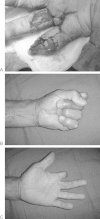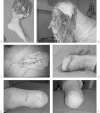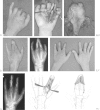Spare-part surgery
- PMID: 24872768
- PMCID: PMC3842344
- DOI: 10.1055/s-0033-1360586
Spare-part surgery
Abstract
The authors discuss the use of scavenged tissue for reconstruction of an injured limb, also referred to as "spare-part surgery." It forms an important part of overall reconstructive strategy. Though some principles can be laid down, there is no "textbook" method for the surgeon to follow. Successful application of this strategy requires understanding of the concept, accurate judgment, and the ability to plan "on-the-spot," as well as knowledge and skill to improvise composite flaps from nonsalvageable parts. Requirements for limb reconstruction vary from simple solutions such as tissue coverage, which include skin grafts or flaps to more complex planning as in functional reconstruction of the hand, where the functional importance of individual digits as well as the overall prehensile function of the hand needs to be addressed right from the time of primary surgery. The incorporation of the concept of spare-part surgery allows the surgeon to carry out primary reconstruction of the limb without resorting to harvest tissue from other regions of the body.
Keywords: microsurgery; reconstruction; replantation; spare parts; trauma.
Figures






References
-
- Midgley R D, Entin M A. Management of mutilating injuries of the hand. Clin Plast Surg. 1976;3(1):99–109. - PubMed
-
- Büchler U. Traumatic soft-tissue defects of the extremities. Implications and treatment guidelines. Arch Orthop Trauma Surg. 1990;109(6):321–329. - PubMed
-
- Buchler U, Hastings H. New York, NY: Churchill Livingstone; 1993. Combined injuries; pp. 1631–1650.
-
- Soucacos P N. Indications and selection for digital amputation and replantation. J Hand Surg [Br] 2001;26(6):572–581. - PubMed
-
- Soucacos P N, Beris A E, Malizos K N, Vlastou C, Soucacos P K, Georgoulis A D. Transpositional microsurgery in multiple digital amputations. Microsurgery. 1994;15(7):469–473. - PubMed
LinkOut - more resources
Full Text Sources
Other Literature Sources

